If you are not redirected automatically, please click on the URL below.
ページが切り替わらない場合は、https://www.english.metro.tokyo.lg.jp/topをクリックしてください。

Please enable JavaScript to use the website of the Tokyo Metropolitan Government.
Main content starts here.
August 9, 2024
Preparing for a “Nankai Trough” Quake
Overview of Nankai Trough Earthquakes and Others
Nankai Trough earthquakes are massive quakes that have repeatedly occurred at an interval of approximately every 100 to 150 years with their epicentral areas located along the plate boundary between Suruga Bay in the central prefecture of Shizuoka and the Hyuganada Sea off the southern main island of Kyushu.
On August 8, an earthquake occurred with its epicenter located in the Hyuganada Sea, registering a maximum 6-minus on the Japanese seismic intensity scale of 7 in Nichinan City, Miyazaki Prefecture.
The Japanese Meteorological Agency subsequently issued its first-ever mega-earthquake advisory, “Nankai Trough Earthquake Extra Information,” on the assumption that the chance of a new Nankai Trough earthquake is relatively high compared to normal conditions.
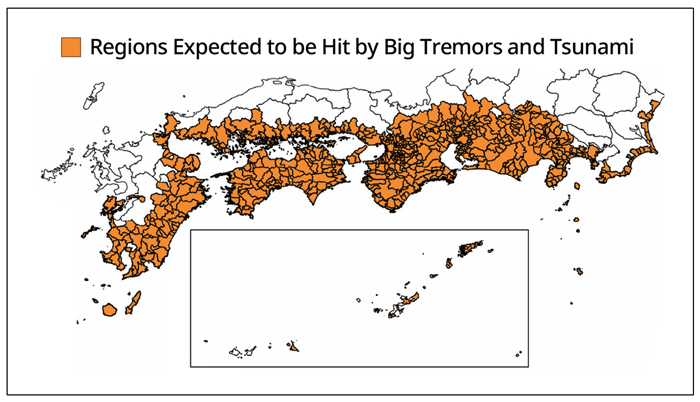
Source: “Manga Explainer! Nankai Trough Quake: If the Day Comes...” (Cabinet Office, Fire and Disaster Management Agency, Meteorological Agency)
TMG Disaster Countermeasures Headquarters Established
- The Tokyo Metropolitan Government (TMG) made emergency deployment arrangements and established a disaster countermeasures headquarters in response to the situation.
- Tokyo Governor Koike Yuriko issued the following comment.
- “The citizens of Tokyo are advised to prepare in case a disaster strikes, including stockpiling daily necessities. Those who live in island regions are advised to make preparations for immediate evacuation.“
- Full text of the Governor’s comment is here(Japanese)
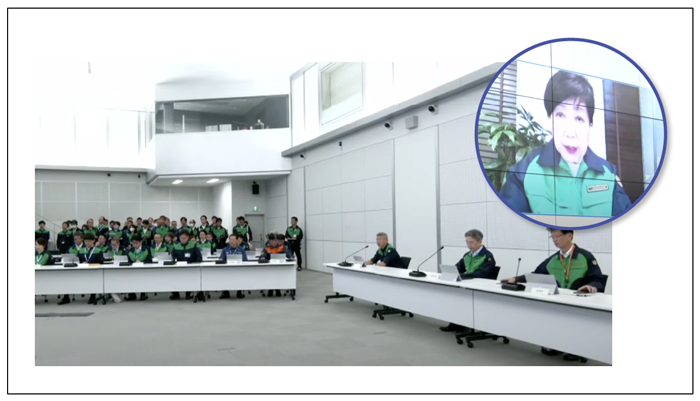
Damage Estimates (tsunami, collapsed buildings, etc.)
In metropolitan Tokyo, buildings are estimated to sway wildly and for a long time due to long-period seismic motions. At the same time, a tsunami is estimated to reach the Tokyo Island regions in a short period of time.
Estimated damage in Tokyo
- Death toll: 953
- Damaged buildings: 1,258
Estimated Tsunami damage
Maximum tsunami height (time until arrival)
Tokyo Bay Area
- Edogawa Ward: 2.24 m
- Koto Ward: 2.63 m
- Chuo Ward: 2.42 m
- Minato Ward: 2.37 m
- Shinagawa Ward: 2.38 m
- Ota Ward: 2.25 m
- Tokyo Bay reclaimed land: 1.99 m
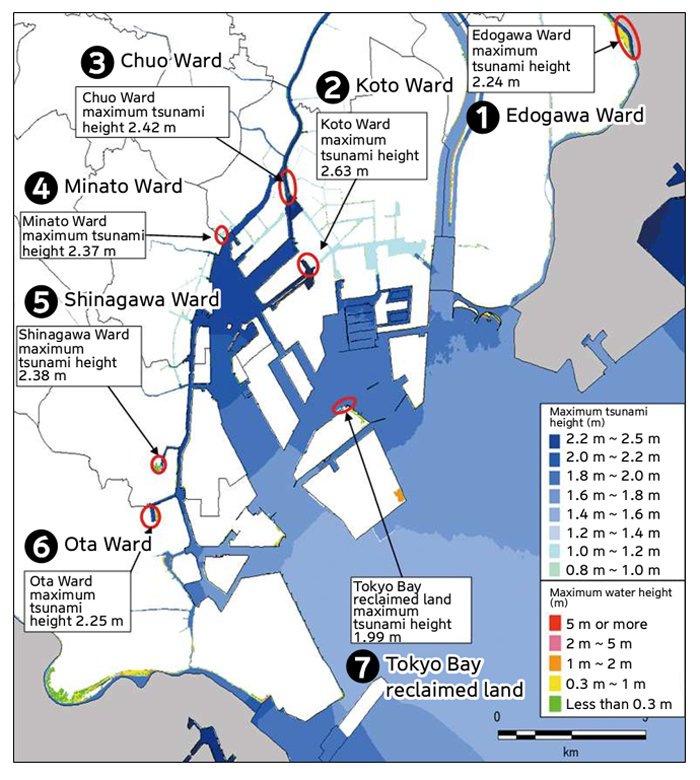
Tokyo Island regions
- Oshima: Approx. 16 m (approx. 23 min.)
- Toshima: Approx. 17 m (approx. 19 min.)
- Niijima: Approx. 27 m (approx. 17 min.)
- Shikinejima: Approx. 28 m (approx. 14 min.)
- Kozushima: Approx. 27 m (approx. 17 min.)
- Miyakejima: Approx. 16 m (approx. 25 min.)
- Mikurajima: Approx. 7 m (approx. 30 min.)
- Hachijojima: Approx. 17 m (approx. 32 min.)
- Aogashima: Approx. 14 m (approx. 36 min.)
- Chichijima: Approx. 15 m (approx. 126 min.)
- Hahajima: Approx. 16 m (approx. 108 min.)

Source: Edited and created based on Tokyo Metropolitan Government
“New Damage Predictions for Tokyo: Predicted Damage to Tokyo from an Earthquake Directly Hitting Tokyo” (May 2022)
If a Nankai Trough Mega Earthquake Were to Occur ...
- In the island regions, tsunami waves exceeding 20 meters in height may reach some islands in as short as ten minutes or so.
- In the event of a tsunami, the first thing to do is to protect your own life.
- High-rise buildings would shake heavily for a long while, causing indoor furniture and appliances to fall over or move and elevators to malfunction.
- In Islands Regions
In the Sanriku region, which is often hit by tsunamis, there is a saying that goes, “Tsunami Tendenko,” which means that when a tsunami occurs, it is important for every person to escape to higher ground, even if they are not with their family, in order to protect their own lives.
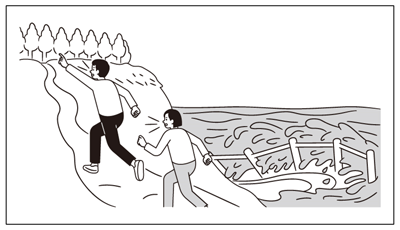
In High-rise Buildings, etc.
High-rise buildings and condominiums would shake heavily for a long while, phenomena called “long-period seismic motions,” causing indoor furniture and appliances to fall over or move and elevators to malfunction.
If an earthquake occurs when you are in an elevator, push all the floor buttons and get off wherever it stops. If you are stuck inside, use the intercom for communication.
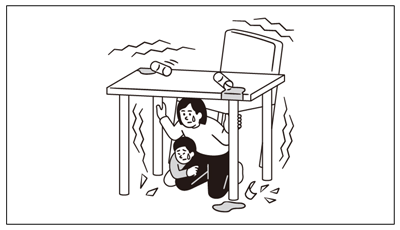
Confirming Evacuation Routes and Boosting Stockpiling of Daily Necessities
Tokyo citizens are advised to reconfirm their daily preparedness against potential disasters,including preventing indoor furniture from falling over and stockpiling daily necessities.
Tokyo Stockpiling Navi
Understand the items and quantities that you need to stockpile by simply answering some simple questions such as your family composition. Start with what you can do for yourself and your loved ones.
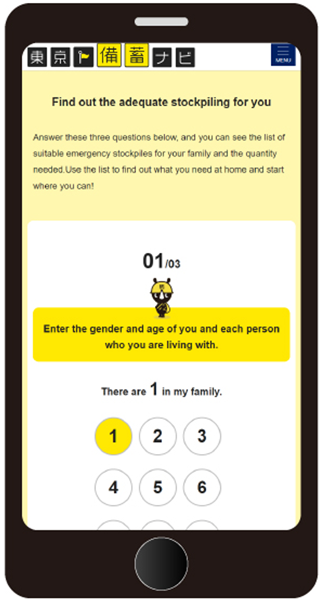
Ensure Your Home’s Safety and Secure Furniture
Secure the furniture in your home to ensure safety in the event of an earthquake. Using fittings such as L-brackers provides greater safety. Pole devices (tension rods) can also be used in rental housing where the walls cannot be damaged, or on walls with a light-gauge steel substrate.
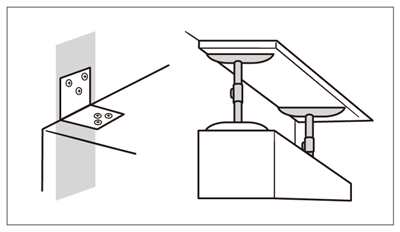
Secure Evacuation Routes and Check Emergency Stairs
Do not use an elevator when moving from floor to floor during an evacuation, and instead use the emergency stairs. This is because even if the elevator is working, there is a possibility that it will stop suddenly due to the earthquake detection sensor functioning, a malfunction, or power outage, and you may become trapped. Confirm the location of the Emergency stairs in advance.
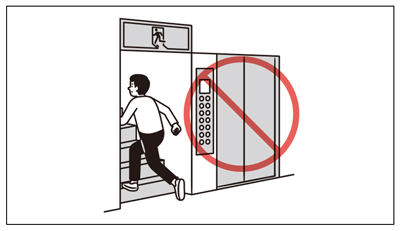
Download the Disaster Preparedness Tokyo app
This is the Tokyo Metropolitan Government’s official disaster preparedness app, which is useful in daily life and in an emergency. The app features content that will be useful in the event of a disaster and allows users to have fun while gaining basic knowledge about disaster preparedness, based on the concepts of “play,” “learn,” and “use.”
Disaster Preparedness Tokyo app

|
Inquiries |
|
(Assistance in Japanese only) |